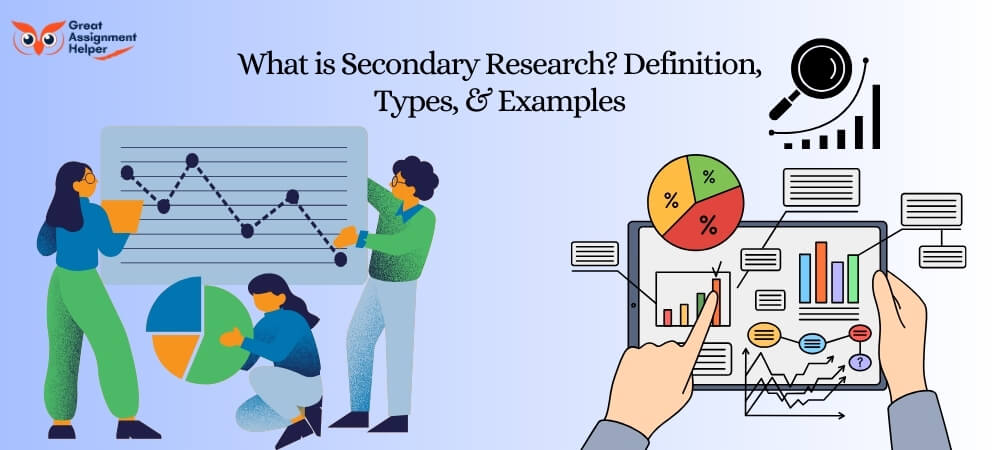
Listen To This Blog
Introduction
Diving into the world of secondary research opens up a treasure trove of insights and data previously gathered by others. This method stands out as a cornerstone for scholars, marketers, and professionals across various fields, offering a pathway to understanding trends, behaviors, and outcomes without the need to start from scratch. By leveraging existing studies, reports, and databases, one can efficiently gather comprehensive information that enriches understanding and supports decision-making. Secondary research serves as a critical tool, enabling us to build upon the foundations laid by predecessors to explore new conclusions or validate existing theories. Whether it's analyzing market trends, reviewing academic literature, or examining case studies, this approach provides a rich, layered understanding of subjects at hand, making it an indispensable part of the research landscape.
When to Use Secondary Research
Choosing the right moment to utilize secondary research can significantly enhance the depth and breadth of your analysis. Here are key scenarios where this research method shines:
- Initial Exploration: Before diving deep into a new area of study, secondary research offers a broad overview, helping to understand the landscape and identify key themes, trends, and gaps in existing knowledge.
- Budget Constraints: When resources are limited, leveraging existing data allows for cost-effective research, avoiding the expenses associated with primary data collection.
- Time-Sensitive Projects: With deadlines looming, secondary research provides quick access to a wealth of information, enabling faster turnaround times for your projects.
- Supporting Primary Research: It acts as a foundation, offering background information and context that can shape and inform the direction of primary research efforts.
- Comprehensive Reviews: For projects requiring a thorough understanding of a subject, such as literature reviews, secondary research compiles and synthesizes existing studies and findings.
- Data Availability: In cases where primary data collection is not feasible due to accessibility issues, secondary research becomes invaluable, utilizing already available data to draw conclusions.
- Benchmarking and Comparative Analysis: It allows for the comparison of your data or findings against established benchmarks or analyses in your field of study.
By recognizing the appropriate situations for its application, secondary research can be a powerful tool in your research arsenal, offering insights and information that are both time-efficient and cost-effective.
Primary Research vs. Secondary Research
When embarking on a research project, understanding the distinction between primary and secondary research is crucial. Each method has its unique advantages, applications, and outcomes, shaping the direction and depth of your study.
Primary Research: A Closer Look
Primary research involves the collection of new data firsthand. This method is tailored to answer specific research questions that existing data cannot address. It's direct and controlled, offering fresh insights and perspectives.
Key Characteristics:
- Customization: Data is gathered directly from the source, allowing research to be highly tailored to specific questions or hypotheses.
- Current Data: Offers the most up-to-date information, capturing the latest trends and opinions.
- Exclusive Insights: Provides unique data that can give a competitive edge or novel insights into a research area.
Applications:
- Exploring new topics where little information exists.
- Gathering specific data points that are not available through existing sources.
- Detailed analysis of behaviors, opinions, or trends.
Secondary Research: Harnessing Existing Knowledge
Secondary research involves the synthesis and analysis of existing data collected by others. It's an efficient way to gain a broad understanding of a topic without the time and cost associated with primary data collection.
Key Characteristics:
- Cost-Effective: Utilizes already available data, saving on the resources needed for data collection.
- Time-Saving: Access to a wide range of data without the need for extensive data gathering processes.
- Broad Overview: Provides a comprehensive background, helping to identify trends, gaps, and key themes in existing research.
Applications:
- Initial exploration of a topic to understand the current state of knowledge.
- Supporting or contradicting primary research findings with existing data.
- Identifying patterns or trends across a wide range of studies.
Choosing the Right Approach
The choice between primary and secondary research depends on several factors, including the research objectives, budget, timeline, and the availability of data. Primary research is best when you need specific, up-to-date information tailored to a particular question. In contrast, secondary research is ideal for gaining a broad understanding of a topic, identifying trends, and informing the direction of further research.
In many cases, a combination of both methods provides a comprehensive view of the research topic, leveraging the depth of primary research with the breadth of secondary research to achieve a well-rounded analysis.
Types of Secondary Research
Secondary research leverages existing data to glean insights, support hypotheses, or inform new research directions. Understanding the various types of secondary research can help researchers choose the most appropriate method for their specific needs.
- Literature Reviews: This involves analyzing scholarly articles, books, and other academic publications to gather insights on a particular topic. Literature reviews help identify trends, gaps, and key theories in existing research.
- Statistical Analysis: Utilizing existing statistical data from government agencies, NGOs, or industry reports to analyze trends, patterns, and relationships within a specific field or subject matter.
- Case Studies: Examining previously conducted case studies allows researchers to explore in-depth insights into particular instances, events, or subjects, providing a detailed understanding of complex issues.
- Meta-Analyses: This method combines data from multiple studies addressing the same question, offering a comprehensive analysis that can reveal broader trends and conclusions than individual studies.
- Market Reports: Industry or market reports provide valuable information on market trends, consumer behavior, and competitive landscapes, crucial for business strategy and market research.
- Historical Records: Analyzing documents, records, and archives to understand past events, developments, or trends, providing context for current situations or future projections.
- Government and Legal Documents: Utilizing public records, policy documents, and legal texts to gather data on regulations, demographic trends, or governmental actions relevant to the research topic.
Each type of secondary research offers unique advantages and can be selected based on the research question, the availability of data, and the scope of the study. By effectively leveraging these different types, researchers can build a robust understanding of their subject matter without the need for primary data collection.
Examples of Secondary Research
Secondary research is a versatile research method that taps into pre-existing data sources to extract valuable insights. Here are some practical examples showcasing how secondary research can be applied across various contexts:
- Market Trend Analysis: A company planning to launch a new product uses industry reports, market analysis documents, and consumer feedback from online forums and social media to understand current market trends and consumer preferences.
- Academic Literature Review: A graduate student conducting a thesis on climate change impacts on coastal communities reviews scholarly articles, climate reports from international organizations, and historical weather data to establish a foundation for their research.
- Competitive Analysis: A business analyst gathers data from competitor websites, industry blogs, and financial reports to compare product offerings, market share, and business strategies.
- Policy Impact Assessment: A policy researcher analyzes government publications, legal documents, and previous studies to assess the impact of a specific policy on public health outcomes.
- Historical Research: A historian uses archives, digital libraries, and historical databases to gather information on a specific event or era, providing context and depth to their analysis.
- Consumer Behavior Study: A marketing team reviews existing consumer research, social media trends, and online reviews to identify changes in consumer behavior and preferences.
Each example demonstrates the application of secondary research in gathering relevant, pre-existing data to inform decisions, support hypotheses, or contribute to new knowledge. This research method proves invaluable across disciplines, offering a cost-effective and efficient way to leverage the wealth of information already available.
Advantages and Disadvantages of Secondary Research
Secondary research, with its reliance on existing data, offers a range of benefits and faces certain limitations. Understanding these can help researchers and professionals make informed decisions about when and how to incorporate this research method into their projects.
Advantages of Secondary Research
- Cost-Effectiveness: One of the most significant advantages is the reduced cost. Since the data has already been collected, researchers can save on the expenses associated with primary data collection processes.
- Time Efficiency: Secondary research allows for quicker access to information. Researchers can analyze and interpret existing data without the time-consuming process of designing studies and collecting data.
- Broad Scope of Data: It provides access to a wide range of data across different geographies and time periods, offering a comprehensive overview that might be difficult to achieve through primary research alone.
- Feasibility: In some cases, primary research may not be practical due to logistical, ethical, or financial constraints. Secondary research offers an alternative path to gather necessary information.
- Benchmarking: It enables researchers to compare their findings or data against broader trends, benchmarks, or standards within their field of study.
Disadvantages of Secondary Research
- Relevance and Specificity: The available data may not perfectly align with the specific objectives or questions of the current research project, potentially limiting its direct applicability.
- Data Quality and Accuracy: The reliability of secondary data can vary, and researchers might not have full insight into how the data was collected, analyzed, or interpreted, raising concerns about its validity for the new research.
- Outdated Information: Depending on the source, secondary data might be outdated, making it less useful for understanding current trends or making future projections.
- Biases: Secondary data may carry the biases of the original researchers or the context in which the data was collected, which can influence the outcomes of the current research.
- Overreliance on Available Data: There's a risk of shaping research questions or directions based on the available data, rather than on the intrinsic importance or relevance of the questions themselves.
In summary, while secondary research offers a practical and efficient way to access a broad spectrum of data, researchers must critically assess the relevance, quality, and timeliness of the data to ensure it meets their needs. Balancing the advantages and disadvantages of secondary research is key to maximizing its potential benefits while mitigating its limitations.
Wrapping Up
In conclusion, navigating the complexities of secondary research can significantly enhance the depth and quality of your scholarly work or business project. Whether you're drafting a research paper, analyzing market trends, or exploring historical data, understanding how to effectively leverage existing data is crucial. For those seeking additional support, Great Assignment Helper offers tailored research paper help, providing expert guidance to refine your approach and ensure your project's success. By integrating the insights gained from secondary research, you can build a robust foundation for your analysis, contributing valuable perspectives to your field of study.

